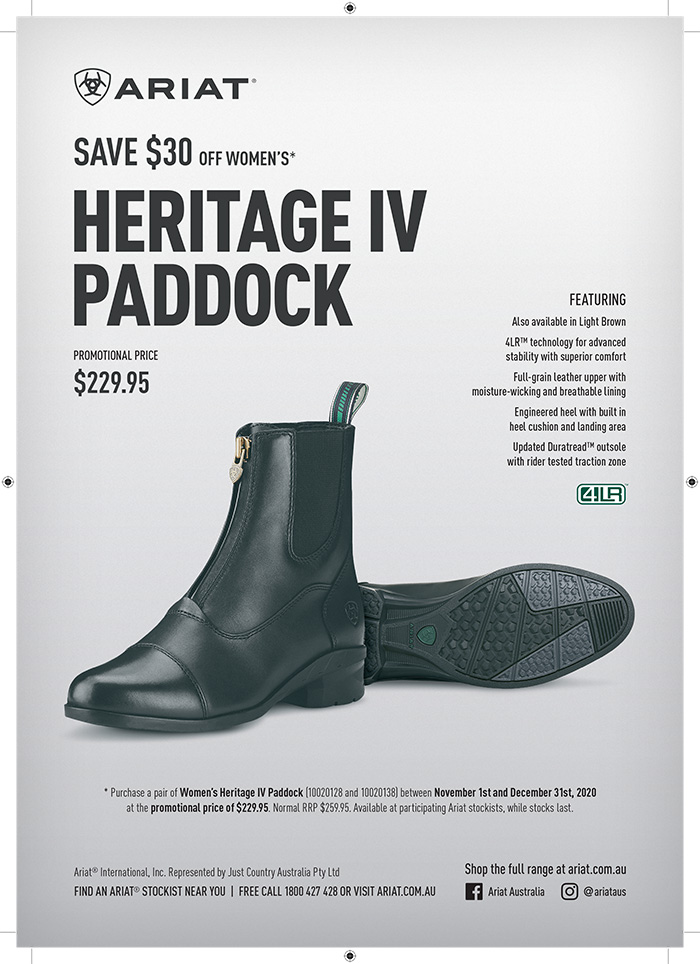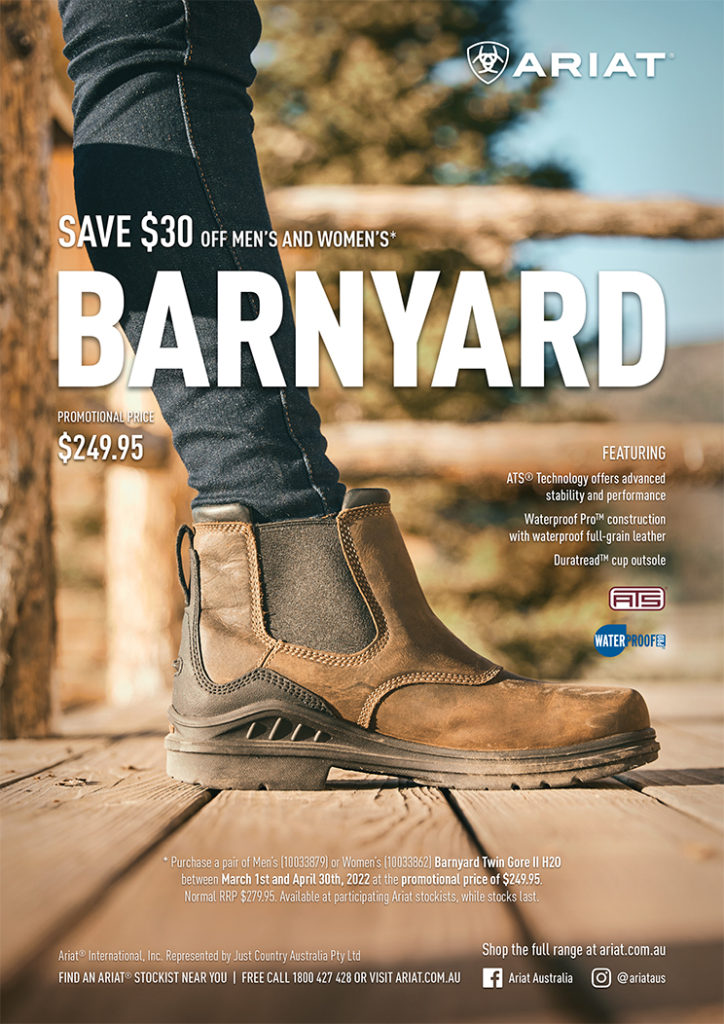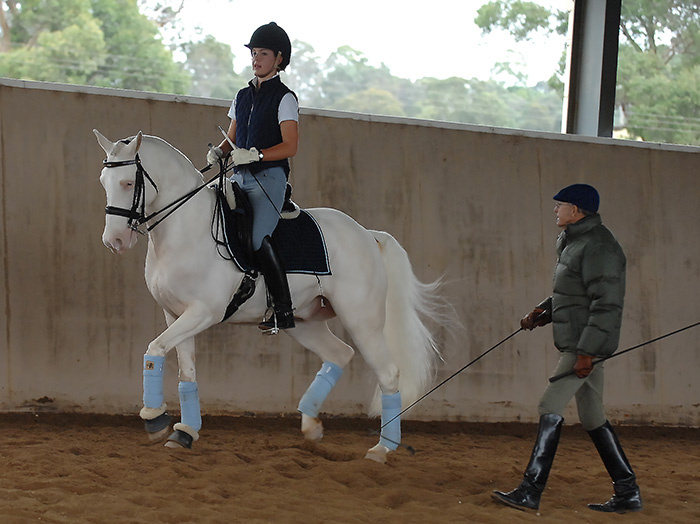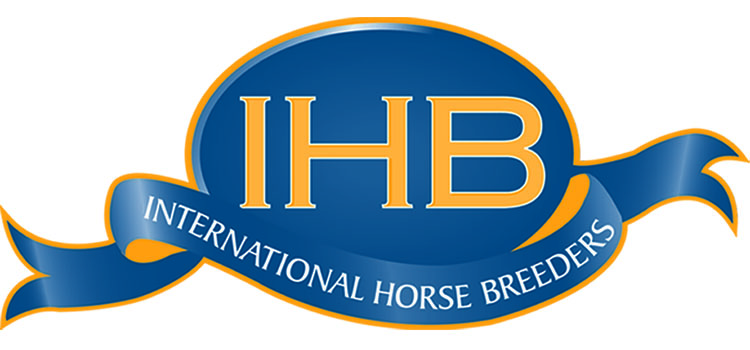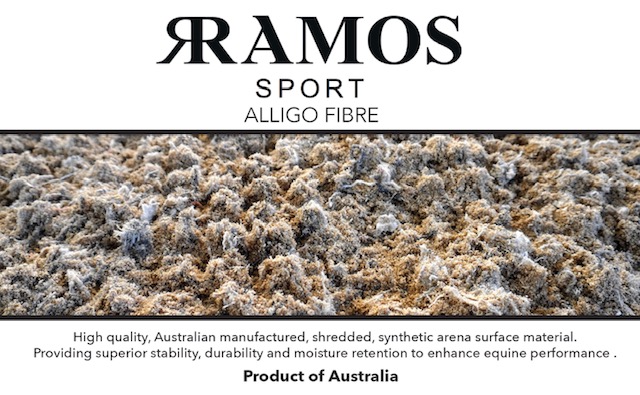Training the Young Rider
We continue our series of articles in honour of my dear friend, the late Miguel Tavora whose death left the equestrian world, and this friend, so much poorer…
Story – Christopher Hector Photos – Roslyn Neave
Part 1 here
Part 2 here
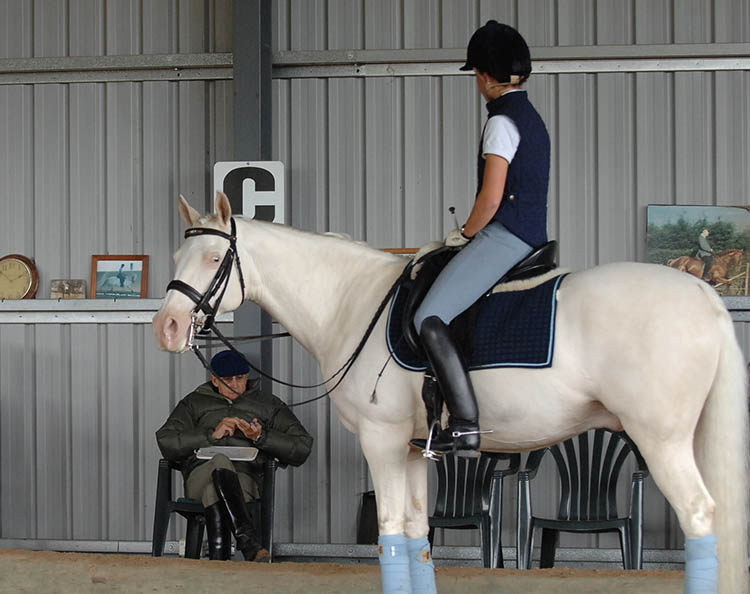
Back in 2005, Robbie Soster was already a star with a rather unusual mount, Robali Irish Cream. Robbie was a fortunate that her mother chose Miguel Tavora as her trainer, and although it was unplanned, Louie turned out to be a trainable and talented mount for Robbie.
Good riding and training produces good horses, one of Miguel’s star pupils, Robbie Soster is in the arena, riding… er… one of the more unlikely looking dressage horses on the scene – Robali Irish Cream. The little (14.3 Hand) creamello was acquired in lieu of an agistment debt, Robbie was a keen show rider at the time, and did a bit of eventing. The little creamy was put into work to sell, and since Robbie’s mother, Ali, was a Miguel fan, that’s where Robbie went for her first lesson. She was twelve, Louie had done nothing – six years later, the pair have defied the colour bar finishing 4th in the National Prix St Georges at the Sydney CDI – and then taking 5th in the Advanced Freestyle to Music. Louie carried Robbie to the Dressage Young Rider of the Year title two years running – 2005 and 2006….
With Robbie, Miguel starts the working session a little differently, on a bigger circle, neck down, and round, slide out in shoulder in along the wall, out and stretch down.
“Is he looser? You must tell me. Make a figure eight, make him round and down, be sure to change the bend. Now walk and canter left.”
And that is exactly what they do – there is not even a hint of a trot step in between.
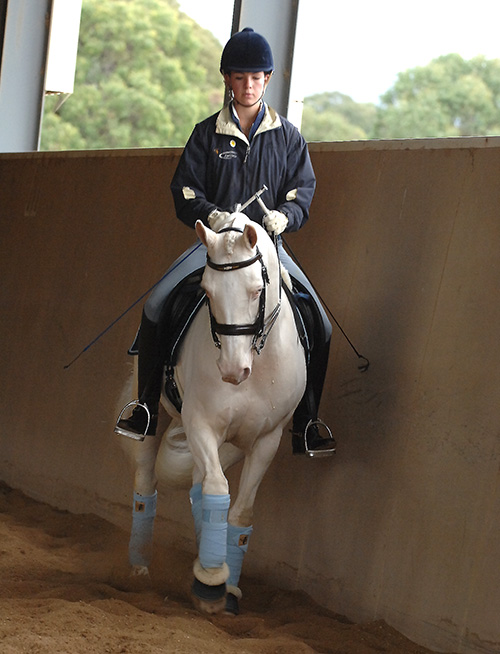
It’s a signature for Miguel’s pupils – perfect walk / canter transitions, perhaps it has something to do with Miguel’s preference for the outside leg as the aid for the canter depart:
“I prefer the outside leg. I can get the horse to canter by tickling it on the ear as long as I am consistent. The signal of the canter is the least important thing, what is important, is to get the horse with the correct balance and the correct impulsion. To me the more clear result comes with using the outside leg because on the canter to the right, the first leg to leave the ground to take the canter is a left hind leg. In all my work, my left leg works on the horse’s left hind leg, my right leg works on the horse’s right hind leg.”
“So if have a horse in the correct position, with impulsion and the balance to take the canter, and I touch with the left leg, the horse takes the canter. If you read Decarpentry, in the beginning of developing flying changes, the horses used to swing a lot with the hindquarters. In the past they didn’t do flying changes. La Guérinière didn’t do flying changes. They had a movement called Terre à Terre, but the horse stopped and then cantered on the other side (see pics below). The flying change is quite a modern exercise and because they didn’t know how to correctly prepare the change, in the beginning there was quite a lot of swinging of the hind quarters.”
story continues below the advertisement
As we remember the legacy that Miguel Tavora leaves us, some years later, we travelled to Portugal and Miguel arranged for us to be shown around the Royal School in Lisbon, and we were fortunate to see the movement Terre à Terre demonstrated. Terre à Terre is a series of levades in which the hind feet jump forward. Looks strange, but amazing. A video would show it better, but if you look at the wall at the back of the picture, you can see what is happening and how the rider uses the exercise to collect the horse.
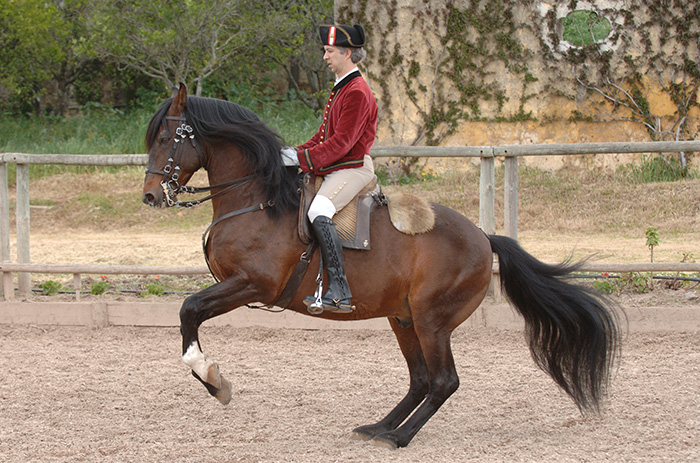
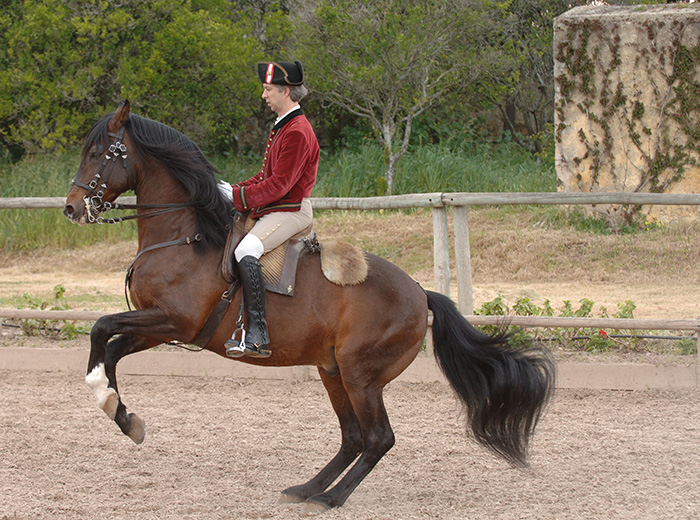
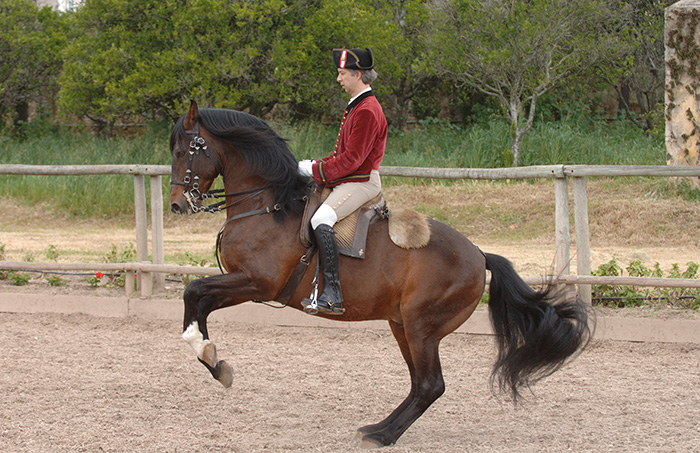
“Some like Podhajsky would say, take the flying change with the inside leg – that is fine, like say I can make the horse change by tickling its ear – in the circus, you see the trainer on the ground make a signal and the horse does a pirouette, so it can be done – but I find it impossible to get the horse to make a flying change every stride if I only use the inside leg. The inside leg is a leg that asks, please, and the outside leg says more than ‘please’. The outside leg says ‘please, but do it!’”
“I trained a horse once to make flying changes with the inside leg, and he did, but after when I went to do the tempi changes, I could never do it. I found that I had to use too much my hands – I think it is better to keep it simple. Put the horse on the right balance and the right impulsion, and keep it simple – the outside leg says, go do it.”
It is interesting that all your pupils do walk to canter departs effortlessly, crisply and correctly…
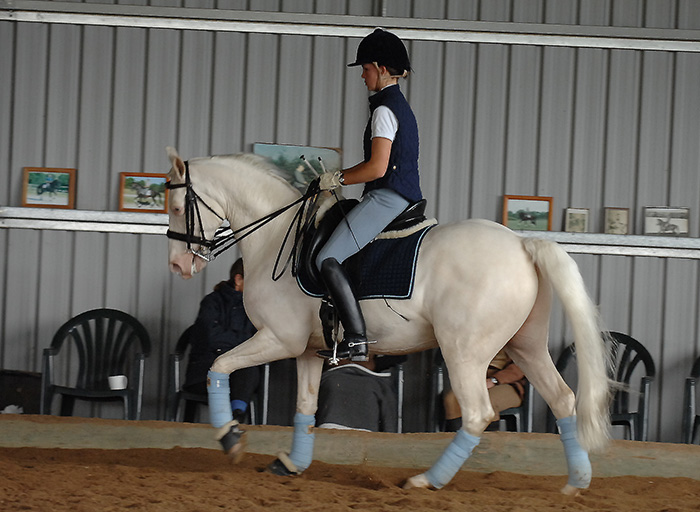
“We work a lot on the canter transition: canter walk canter because it is very good exercise to collect and to improve the canter. The small circle around the inside leg prepares the horse well for canter because with that small circle around the inside leg, I can get the impulsion, the balance, and the bend, and the position to make the transition – that helps a lot, along with practice, practice, practice – and never opposing the legs with the hands. I prepare, now outside leg, and canter – hands are relaxed, just a small soft contact, and canter. Practice especially on the circle, sometimes on the ten metre circle, because on the circle we have much more control, the horse is made supple, to bend he needs to be supple, everything passes through without resistance – but on the wall, on the straight line, it is more difficult. Practice first on the circle and you will not have problems.”
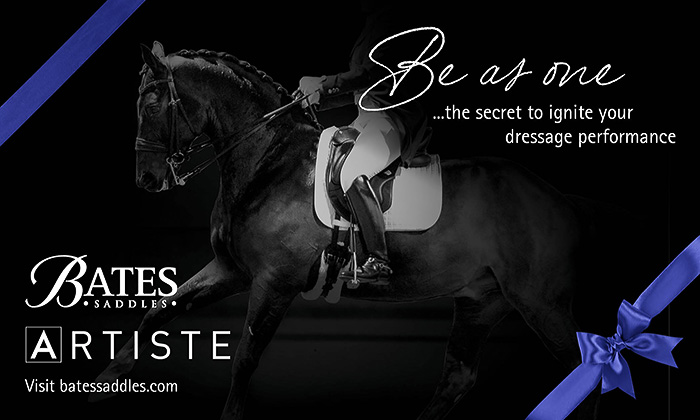
And sure enough, it is time to work on the flying change, but not just any change, it must have expression – once again, Miguel has picked up his white board marker and is drawing a diagram to clarify the exact moment of the change.
“We are training. When you think you can get maximum expression, then ask the flying change, if not, don’t do it!”
As always, Miguel likes to break up the session with twenty metre circles in rising trot, and once again, Louie is deep and round, with Robbie asking for a little outside flex to loosen him more. Once again the little walk circle around the inside leg. Now walk, haunches in, straight, rein back, walk. Trot, haunches in on a circle, walk, rein back. Trot, haunches in on a slightly smaller circle, again, walk, rein back, trot circle, haunches in, shoulder in, haunches in – and walk, ‘very calm walk’.
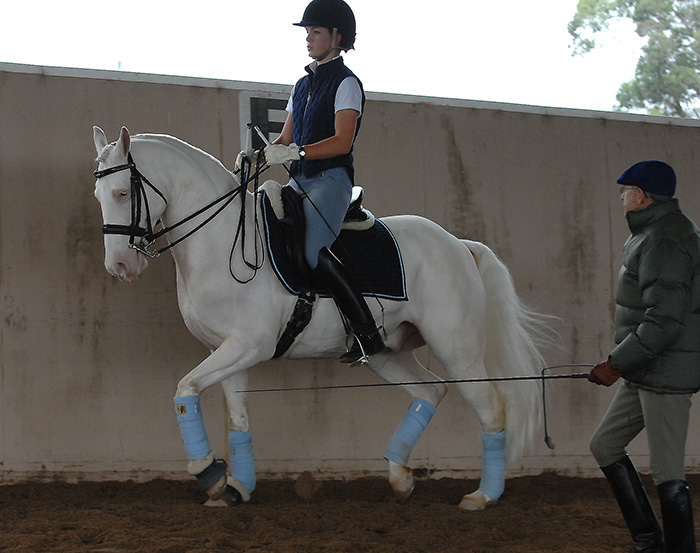
Miguel takes the long whip, and taps the little horse, sometimes on the foreleg, sometimes on the hindquarters.
Again using the rein back, again renvers to travers and into some beautiful passage.
“Very good.”
Miguel Tavora talks about working with Robbie and Louie:
“We see with this horse, just by travers / renvers, travers / renvers, bang – straight into passage. Robbie was already on the balance of the passage, engaged, so all she needed was a little half halt, and passage. If I just go on the straight line then I would have to kick and pull, to put the brick wall there to make the horse shorter.I don’t want to make the horse shorter. I want to make the horse shorter because he is rounder not because he is shorter, squeezed, jammed.”
You use rein back quite often, yet that is a movement that often causes problems?
“Rein back is a very good gymnastic for the hindquarter and the back, as long as you have the horse suppled enough through your lateral work, and the horse is surely in front of your legs, there shouldn’t be a problem. Of course when you rein back, you have to be very careful that the horse is round – if the horse is not in the right posture, if he is hollow, he puts the weight on the forehand – it is very dangerous, very dangerous, to rein back if you do it the wrong way.”
“If you are going to rein back, you must be sure that the poll is up, be sure that the poll is flexed and the horse is on the bit, then you feel yourself being pushed up, not dropped down – the horse keeps the right rhythm, and you are sure that you can stop whenever you want, then the rein back is a very good exercise. It is a good exercise like shoulder in, or travers or renvers. If you combine shoulder in with straight halt, rein back, trot on, that it a fantastic suppling exercise. Travers and renvers, halt, rein back, trot on, is a fantastic exercise to start the piaffer. Travers, renvers, rein back, trot on and when you trot you restrain a bit and the horse will make two steps of piaffe.”
“If you have a horse that has the tendency to drop on the forehand very easily on the down transitions, then instead of just a down transition, make the transition and immediately rein back – make him shift the weight back – that is the way to make the horse accept the half halts.” more follows
New stallions available from IHB this season click above and check them out!
“All exercises that you do, they have their risk of being dangerous. If they are not correctly done, a simple circle can be damaging to the horse. A simple walk on the long rein can be dangerous! I don’t see that the rein back is more dangerous than a wrong shoulder in, or a wrong half pass.”
In the canter, once again the three track movements play a crucial role. Haunches in, spiralling the circle smaller – “Very good, now open up and medium canter… now again the haunches in, now shoulder in… and let the pirouette come.” And that’s exactly what happens, because of the exercises, the horse wants to do the pirouette.”
“It’s very important that when you are doing this work in renvers and travers that the horse may lose some engagement in the renvers, but he has more activity.”
“We see with this horse, just by travers / renvers, travers / renvers, bang – straight into passage. She was already on the balance of the passage, engaged, so all she needed was a little half halt, and passage. If I just go on the straight line then I would have to kick and pull, to put the brick wall there to make the horse shorter. But I don’t want to make the horse shorter. I want to make the horse shorter because he is rounder not because he is shorter, squeezed, jammed. If people rode like this, then I guarantee you would not see the problem of the neck getting shorter, shorter, shorter.”
story continues below the advertisement
“I find that very bad, now you see horses starting Grand Prix with their neck one metre long, then it is 90, 80, 70, you are worried they are going to finish with the nose jammed on the chest. The problem is that the half halt is not passing through, it must pass through the neck and the back.”
“I like to be able to put my little finger on the rein, and play and the horse’s left fetlock joint flexes a bit – it passes through. If the horse jams the neck, it doesn’t pass through.”
It was interesting with Robbie when you wanted to move from passage – which the horse had a good idea of – to the piaffe, you were saying use the renvers, and that even if that disengages, it creates more activity. You talk about this concept?
“We must understand that we don’t train piaffer from passage, or passage from the piaffer. We train piaffer and passage – and after, we put them together, when they know piaffe and they know passage. If you try to train one from the other, you may end up with a horse that begins walking in the piaffer or a horse that tries to make passage on the spot – and of course, he then blows up.”
“The balance of the passage is different to the balance of the piaffer. On the piaffe the horse is much more engaged and trots on the spot – in the passage the horse is much less engaged, he is less engaged in the passage than he is in the collected trot. What is collection? Collection is the way the horse uses the engagement. If it uses the engagement to push more upwards, then it is more collected; if the horse uses the engagement to push on the horizontal, then the horse extends the trot. In the extended trot the horse is much more engaged than when it makes passage.”
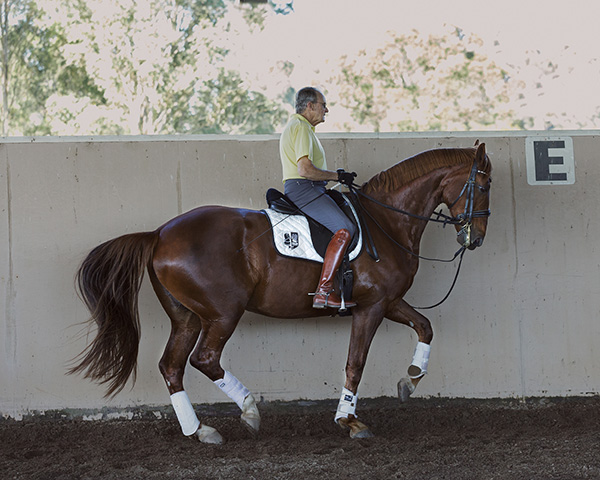
“If the horse starts piaffer, and I am giving the aids, and he comes too much under, then he gets more engagement than he needs to have for the passage. The way I use it, is making a small circle in the renvers position, in the renvers I push the hindquarters a bit out – I make him disengage a bit, I keep the horse collected, but by making a bigger circle with the hindquarters than the forehand, he has to disengage a bit, he might even come on to the forehand a bit, and you have to be careful to half halt to stop this happening. When you do this renvers on the little circle, he starts to slow down, putting the hind leg out, out, out and getting the idea that I don’t want him to go in the balance of the piaffer – now straight to passage.”
I think some people have a problem understanding the difference between the piaffe and passage… you were saying that perhaps the old Masters who did teach the passage out of piaffe were just walking forward…
“The horses were completely different then, and so was the passage they were doing. La Geurinière describes two passages – and I have seen them with the Iberian horses. Passage at the walk, and the passage at the trot. That tells you something straight away – that the passage was not in fact a piaffer marching, and not really the passage that we see nowadays. I’ve trained thousands of horses to do passage and piaffer, and never did it exactly the same way. It was always taboo to try to make passage from piaffer. I only ever tried it once with a very difficult horse, I tried from piaffe to passage, and it was a disgrace. Every time I tried to do passage, he would run in the piaffer, and I had to put the horse into Spanish Walk – which is a circus trick – to make him understand the passage.”
Passage and Piaffe in de la Guérinière’s day – and a modern master, Ignacio Ramblas & Distinguado in passage
“Piaffe is a trot on the spot, with little suspension. Passage is a trot moving with suspension, with swinging… It should look slower because the horse spends more time in the air and it is covering ground. Of course there are some horses in piaffer they have some suspension, and some have very little suspension, but still the piaffer is very good.”
“The biggest problem is that the judges are measuring how much the horse comes off the ground with the hind legs. Some horses to get engaged, they can come too much off the ground with the hind legs. There is a very famous horse that won two gold medals, and yet the piaffer was absolutely on the forehand. If the horse leans a bit on the forehand, then the hind legs come more off the ground – you look at the video of Rembrandt, and you will see what I mean. Of course the judges are going to give better marks because the horse comes off the ground, the riders want to win, the trainers need to pay their debts – so they put the horse on the forehand and then the horse comes more off the ground behind.”
Miguel is well pleased with his talented pupil and her little horse: “With a small horse like this, the rider has half the time to react – when you go to a big horse, oh it is so easy, you have so much more time…”
